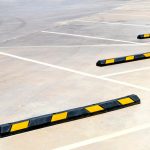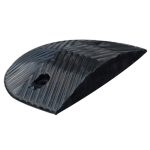Definition and Purpose
Parking bumpers, also known as wheel stops or parking blocks, serve a fundamental role in managing and organizing parking lots. Their primary purpose is to prevent vehicles from rolling beyond the designated parking area, thereby avoiding damage to property or landscaping, and creating a safer environment for both vehicles and pedestrians.
Parking bumpers come in various shapes and sizes, tailored to different parking environments:
- Concrete: Durable and heavy, ideal for permanent installation.
- Rubber: Flexible and less damaging to vehicles upon impact.
- Plastic: Lightweight and often made from recycled materials.
- Metal: Sturdy with high visibility, but can cause more damage to vehicles.
The correct installation of parking bumpers can significantly reduce the likelihood of parking mishaps and contribute to a well-organized parking space.
Different Types and Materials
Parking bumpers come in a variety of types and materials, each suited for specific environments and vehicle types. Concrete bumpers are the most traditional and are known for their durability and strength, making them ideal for heavy-duty applications. Alternatively, rubber bumpers offer more flexibility and are less likely to cause damage to vehicles upon impact.
- Plastic bumpers: Lightweight and often made from recycled materials, they are resistant to weather and corrosion.
- Polyurethane bumpers: Combining durability and flexibility, these bumpers can withstand significant force without cracking.
- Steel bumpers: Extremely strong and long-lasting, they are typically used in industrial settings where heavy vehicles operate.
The choice of material significantly affects the performance and longevity of parking bumpers, with each type offering distinct advantages in terms of impact absorption, weather resistance, and maintenance requirements.
When selecting a parking bumper, it’s crucial to consider the specific needs of the parking area, such as the types of vehicles using it, the climate, and the expected traffic volume. This ensures that the bumpers will provide the necessary protection while minimizing wear and tear.
Appropriate Usage Scenarios
Parking bumpers are versatile tools that can be employed in various scenarios to enhance safety and organization in parking areas. Their strategic placement is crucial for maximizing their effectiveness. For instance, parking bumpers are essential in delineating parking spaces, preventing vehicles from encroaching into pedestrian zones, and protecting landscaping features.
- Residential Complexes: To safeguard walkways and green spaces.
- Commercial Establishments: For orderly parking and to shield storefronts.
- Schools and Hospitals: To ensure emergency vehicle pathways remain clear.
- Industrial Sites: To separate loading areas from parking zones.
When considering the implementation of parking bumpers, it’s important to assess the specific needs of the site. This includes traffic flow, the volume of vehicles, and the presence of vulnerable areas that require protection.
Advantages of Installing Parking Bumpers
Vehicle Safety and Protection
Parking bumpers play a crucial role in enhancing vehicle safety by preventing cars from rolling beyond parking spaces. They act as physical barriers, reducing the likelihood of vehicular accidents within parking lots.
- Prevent cars from overrunning parking spots
- Minimize the risk of collisions with pedestrians or storefronts
- Protect vehicles from accidental damage
Parking bumpers are an essential component in safeguarding both parked and moving vehicles, as well as nearby structures.
The correct installation of parking bumpers can significantly decrease the chances of minor parking mishaps that often result in costly repairs. By delineating parking spaces clearly, they also assist drivers in maneuvering their vehicles more confidently and safely.
Pedestrian Safety Enhancements
Parking bumpers from https://unimat-traffic.com/ play a crucial role in improving pedestrian safety in parking areas. They create clear demarcations between vehicle and pedestrian zones, reducing the likelihood of accidents and injuries. By guiding vehicles to stop at a safe distance, parking bumpers ensure that walkways and crosswalks remain unobstructed.
- Visibility: High-contrast colors improve visibility for drivers.
- Physical Barrier: Acts as a deterrent against vehicles overstepping designated areas.
- Orderly Flow: Encourages an organized flow of pedestrian traffic.
Parking bumpers contribute to a safer environment by preventing vehicles from encroaching into spaces designated for foot traffic. This separation is vital in busy parking lots where the interaction between pedestrians and vehicles is frequent.
The strategic placement of parking bumpers can significantly reduce the risk of pedestrian accidents. For instance, placing them near crosswalks and sidewalks ensures that drivers are aware of safe stopping points. This is especially important in environments such as schools, shopping centers, and hospitals, where pedestrian activity is high.
Improved Parking Space Management
Parking bumpers play a pivotal role in optimizing the use of space within parking lots. Their strategic placement can delineate parking spots clearly, ensuring that vehicles are parked in an orderly fashion. This not only maximizes the number of vehicles that can be accommodated but also facilitates smoother traffic flow within the parking area.
By preventing cars from overrunning parking spaces, parking bumpers contribute to a more efficient use of the available area, reducing the likelihood of parking-related congestion.
Effective parking space management with the help of parking bumpers can lead to several improvements:
- Enhanced ability to accommodate more vehicles
- Minimized risk of parking lot accidents due to clearer lane demarcations
- Streamlined parking for users, leading to a reduction in time spent searching for a spot
These benefits are particularly significant in high-density areas where parking space is at a premium. The proper use of parking bumpers can transform a chaotic parking lot into a well-organized area that supports the needs of both drivers and property managers.
Benefits for Property Owners and Managers
Reduced Property Damage
The installation of parking bumpers can significantly diminish the likelihood of property damage on premises. Parking bumpers act as a physical barrier, preventing vehicles from overrunning parking spaces and colliding with buildings, sidewalks, or landscaping. This protective measure is particularly beneficial in areas with high vehicle turnover or limited space.
- Preventative: By delineating parking spaces, bumpers reduce the risk of accidental property damage.
- Cost-effective: Lower repair costs for buildings and grounds.
- Aesthetic preservation: Maintains the visual integrity of the property.
The strategic placement of parking bumpers is a proactive approach to safeguarding property assets, ensuring that the environment remains unscathed by parking mishaps.
Lower Maintenance Costs
Installing parking bumpers can lead to significant savings in maintenance costs for property owners and managers. The durability and low upkeep requirements of parking bumpers mean fewer repairs and replacements over time. This translates into a more cost-effective solution compared to other parking management systems that may require more frequent attention.
- Preventative Savings: Parking bumpers act as a preventative measure, reducing the likelihood of damage to parking surfaces and landscaping, which can be costly to repair.
- Longevity: Quality parking bumpers are designed to withstand various weather conditions and heavy use, ensuring a longer lifespan with minimal maintenance.
- Simplified Maintenance: The simplicity of parking bumper designs allows for easy cleaning and upkeep, without the need for specialized equipment or labor.
By investing in parking bumpers, property owners can enjoy a more predictable and reduced expenditure on parking area maintenance, freeing up resources for other property enhancements or operational costs.
Enhanced Property Aesthetics
The installation of parking bumpers can significantly enhance the visual appeal of a property. These functional elements, when chosen carefully, can complement the overall design and landscape of a parking area. Aesthetic considerations might include the color, shape, and material of the bumpers, ensuring they blend seamlessly with the surroundings.
A well-designed parking area with matching parking bumpers can create a positive first impression for visitors and can reflect the property owner’s attention to detail and commitment to quality.
Moreover, the uniformity that parking bumpers provide to parking spaces can contribute to a neat and organized appearance. This visual order not only aids in navigation but also promotes a sense of professionalism and care. Below is a list of aesthetic improvements associated with parking bumpers:
- Visual consistency across parking spaces
- Alignment with property design themes
- Enhanced curb appeal
- Subtle yet effective branding (with customized designs)
Ultimately, the choice of parking bumpers can be a minor but impactful part of a property’s aesthetic strategy, influencing how the space is perceived by both frequent users and first-time visitors.
Practical Considerations for Implementation
Choosing the Right Parking Bumper
Selecting the appropriate parking bumper for your facility involves considering several factors to ensure compatibility and effectiveness. Material composition is a critical aspect, as it determines the durability and suitability for specific environments. For instance, rubber bumpers are ideal for indoor parking lots due to their shock-absorbing properties, while concrete or steel bumpers are better suited for outdoor use where they can withstand harsher conditions.
When evaluating options, also take into account the design and size of the bumpers. They should align with the dimensions of parking spaces and be visible enough to guide drivers without obstructing pedestrian pathways. Here’s a quick checklist to aid in your decision:
- Assess the parking area’s environment (indoor vs. outdoor)
- Determine the required durability based on traffic volume
- Consider visibility and reflectivity for driver guidance
- Ensure compatibility with the parking lot’s dimensions
It’s essential to strike a balance between functionality and cost-effectiveness. While higher-quality materials may come at a premium, they can offer greater longevity and reduce the need for frequent replacements.
Lastly, consult with professionals who can provide insights into local regulations and installation standards. This will help you avoid potential compliance issues and ensure that your parking bumpers serve their intended purpose effectively.
Installation Best Practices
Proper installation of parking bumpers is crucial for their effectiveness and longevity. Ensure that the installation surface is level and clean before placing the bumpers. This prevents instability and potential movement over time. Use appropriate hardware for the surface type, such as concrete anchors for concrete surfaces or spikes for asphalt.
- Preparation: Clear the area of debris and measure the space accurately.
- Alignment: Position the bumpers straight and evenly spaced.
- Securing: Use the correct fasteners for your surface type.
- Final Checks: Inspect the installation to confirm stability and correct placement.
When installing multiple parking bumpers, it’s important to maintain uniformity for both aesthetic and functional purposes. Consistent spacing not only looks better but also ensures that each parking space is clearly defined and vehicles are adequately protected.
Maintenance and Durability
The longevity and low upkeep of parking bumpers are significant factors in their overall cost-effectiveness. Proper maintenance ensures that parking bumpers retain their functionality and appearance over time. Regular inspections can identify wear and tear or damage that may compromise their effectiveness.
To maintain the durability of parking bumpers, it is essential to follow the manufacturer’s guidelines for care and to address any issues promptly.
Parking bumpers made from different materials may require varying levels of maintenance. For example, rubber bumpers might only need occasional cleaning, while concrete ones could require sealing to prevent weathering. Below is a list of common maintenance tasks:
- Inspect parking bumpers regularly for visible damage.
- Clean the bumpers to remove dirt and debris.
- Repair minor cracks or chips to prevent further deterioration.
- Replace bumpers that are severely damaged or have reached the end of their service life.
The Economic Impact of Parking Bumpers
Cost Savings Over Time
Implementing parking bumpers can lead to significant cost savings over time. By reducing the frequency and severity of parking-related accidents, property owners can save on repair costs and potential legal fees. Additionally, the longevity of parking bumpers means that once installed, they require minimal replacement or maintenance, further reducing long-term expenses.
- Initial investment in high-quality parking bumpers may be higher, but the durability pays off.
- Savings from reduced property damage and maintenance needs accumulate over the years.
- Efficient parking management facilitated by bumpers can lead to better utilization of space and, consequently, higher revenue from parking facilities.
The economic benefits of parking bumpers extend beyond the immediate prevention of accidents. They contribute to a more streamlined parking experience, which can enhance the reputation of the property and attract more visitors or tenants.
Increased Parking Efficiency
Parking bumpers play a pivotal role in maximizing the efficiency of parking lots. By delineating clear parking spaces, they help drivers quickly identify where to park, reducing the time spent searching for a spot. This organization leads to a smoother flow of traffic within the parking area, as drivers are less likely to hesitate or make sudden maneuvers that can cause congestion.
- Streamlined parking process: Drivers spend less time looking for spaces.
- Optimized space usage: More cars can fit into the same area.
- Reduced traffic congestion: Clear demarcation minimizes driver confusion.
The strategic placement of parking bumpers can transform a chaotic parking lot into a model of efficiency, where every vehicle is neatly parked in its designated spot, leaving no room for ambiguity or wasted space.
Furthermore, parking bumpers can contribute to a more orderly evacuation in case of emergencies, as they prevent cars from blocking critical pathways. The overall impact is a parking lot that not only looks better but functions more effectively, providing a positive experience for drivers and property managers alike.
Potential for Reduced Insurance Premiums
The strategic implementation of parking bumpers can lead to reduced insurance premiums for property owners. By minimizing the risk of vehicle damage and accidents within parking areas, insurers may recognize the lowered liability and offer more favorable terms. This can translate into significant savings over time.
The reduction in claims due to enhanced safety measures directly impacts insurance costs, making parking bumpers a wise investment for long-term financial planning.
Insurance companies typically assess risk based on historical data and the likelihood of future claims. Parking bumpers serve as a proactive measure to reduce such risks. Here’s a simplified example of how insurance premiums might be affected:
- Before Parking Bumpers: High incidence of minor collisions and vehicle damage claims.
- After Parking Bumpers: Decreased number of claims due to effective vehicle containment and protection.
By demonstrating a commitment to safety and risk management, property owners can negotiate with insurers for better rates. The economic impact of this can be substantial, especially for large parking facilities.
Conclusion
In conclusion, parking bumpers serve as an essential tool in managing parking spaces efficiently and safely. They offer a multitude of advantages, from delineating parking spots and protecting vehicles from damage to enhancing pedestrian safety and maintaining order in parking areas. The benefits of using parking bumpers extend beyond the immediate convenience to include long-term cost savings from reduced accidents and maintenance needs. Whether in a commercial lot, residential area, or public space, the implementation of parking bumpers contributes to a more organized and secure parking environment for all users.
Frequently Asked Questions
What are parking bumpers and why are they used?
Parking bumpers, also known as wheel stops or parking blocks, are solid barriers placed at the end of parking spaces to prevent vehicles from rolling beyond the designated parking area. They are used to protect pedestrians, property, and vehicles from accidental damage.
What materials are parking bumpers made from?
Parking bumpers can be made from various materials, including concrete, rubber, plastic, and recycled materials. Each type has its own set of advantages in terms of durability, cost, and environmental impact.
How do parking bumpers enhance pedestrian safety?
Parking bumpers create a clear separation between vehicle traffic and pedestrian walkways, reducing the risk of accidents. They also ensure that cars do not encroach onto sidewalks or into buildings, providing a safer environment for pedestrians.
What are the long-term benefits for property owners who install parking bumpers?
Property owners benefit from reduced property damage, lower maintenance costs due to less frequent need for repairs, and an overall enhancement of property aesthetics, which can increase the property’s value and appeal.
What should be considered when choosing the right parking bumper for a facility?
When selecting a parking bumper, consider the type of vehicle traffic, the parking environment, the desired durability, and aesthetic requirements. It’s also important to comply with local regulations and standards.
Can the installation of parking bumpers lead to economic benefits?
Yes, parking bumpers can lead to economic benefits such as cost savings over time due to reduced damages, increased parking efficiency by maximizing space usage, and potentially reduced insurance premiums due to improved safety measures.






